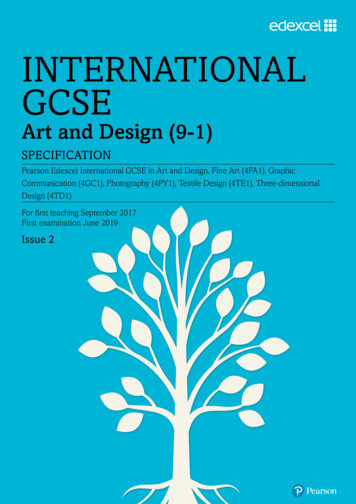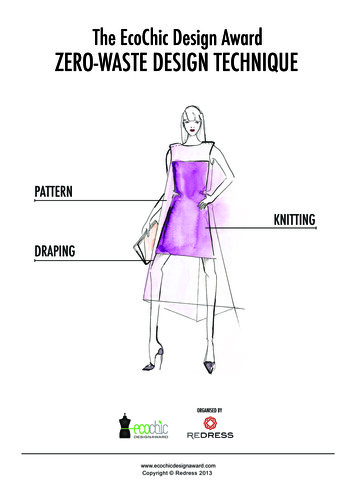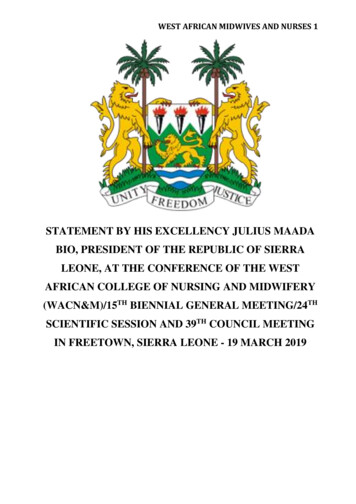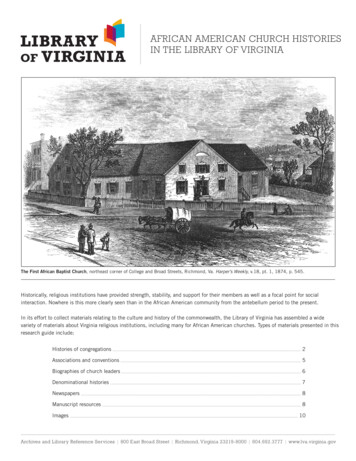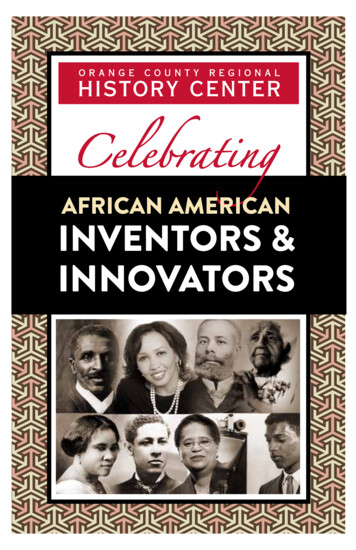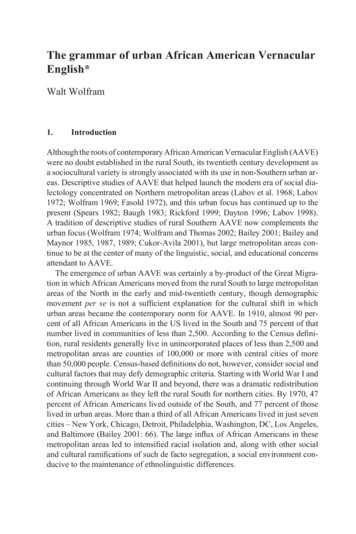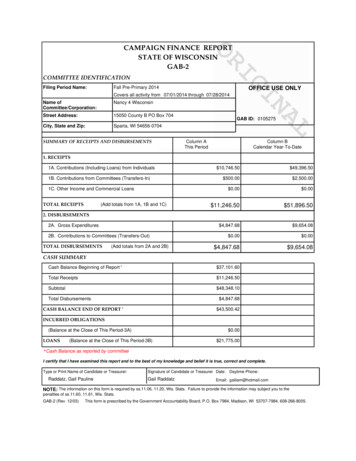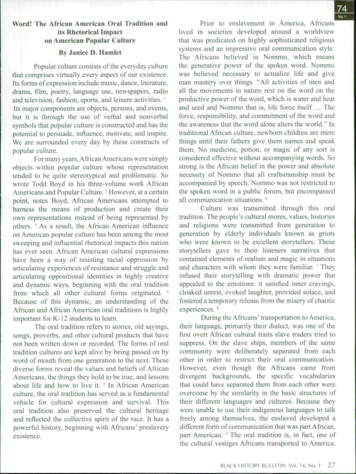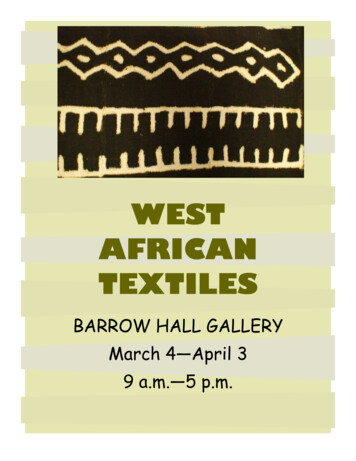
Transcription
WESTAFRICANTEXTILESBARROW HALL GALLERYMarch 4—April 39 a.m.—5 p.m.
WEST AFRICAN TEXTILESExhibit curated by José Blanco and Jennifer Regan withassistance from Dr. Patricia Hunt-Hurst, Raúl Vázquez-López, and students from TXMI 4580: World Textiles(Jessica Baker, Allie Bashuk, Lauren Fylstra, SaraIdacavage, Rachel Jack, Ashley Scruggs, Kim Stober,Danielle Walsh).
Unknown makerLight teal and brown two piecefemale outfit,Burkina FasoCotton, synthetic embroideryOn loan from Dr. Karim TraoreThis female outfit represents the colorful and flamboyantprints of modern African fashion which contrast the handwoven designs of traditional African dress. It isinteresting to note that the modern print of the ensembleis not a traditional African design and resembles the artdeco style of the early twentieth century. The pattern iscreated by a wax-printing process that has been copied bythe Europeans. Interestingly, English wax-printed fabricshave become prestigious items in Nigeria costing morethan the local outputs of the region. The fabric isinscribed with the words “Guaranteed English Wax”therefore verifying the quality of the print. The secondinteresting feature of this ensemble is the colorfullyembroidered collar around the neckline of the caftan thatappears to be industrially made. The decorative elementsof the ensemble indicate that it is probably intended forspecial occasions.
Unknown makerTeal Kampala fabric withwhite and orange print,NigeriaCotton brocadeOn loan from Dr. Akinloye OjoThis piece is similar to Kampala textiles created in Uganda.The material is likely a damask weave created with asynthetic fiber. The eyelet design is characteristic ofAfrican textiles and the piece was probably created with awax print. Clear yellow, orange and green are preferredcolors in Eastern areas of Nigeria. This type of textile isoften used for woman’s “wrapper,” which is a cloth tiedaround the bottom half of a woman resembling a skirt or asa head wrap. Due to Nigeria's richness in languages, thename used for head wrap is different in each language, butmany people choose to use the Yoruba term “gele.”
Unknown makerBrown wax printed boyattire, NigeriaUnknown materialOn loan from Dr. AkinloyeOjoThis is a boy top and bottom worn in Nigeria decoratedwith a wax-printed technique. In the late eighteenthcentury, European manufacturers located in South Africarealized that their African customers were rejecting theEuropean styled clothing they were producing. This ledthe manufacturers to start producing clothing that wouldbe suitable for sale in Africa. Towards the end of the 19thcentury, a Belgian printer named J.B. Previnanaredeveloped the African wax-cloth. He adapted a Frenchnote printing machine that applied resin to the surface ofcotton cloth. Even though this technique is called waxprint, the actual substance put on the cotton fabric isactually a type of resin (not wax). During the wax-printingprocess, the resin cracks which gives the textile itscracked look. This cracked look was an essential featurefor the African consumer. Once this kind of garment wasbeing produced in West Africa for sale, the designs wereadapted to meet the specific needs for particular Africancolonies, including Nigeria.
Unknown makerBlack printed Kampala fabric,NigeriaCotton BrocadeOn loan from Dr. Akinloye OjoThis textile is known as a kampala, which is a type ofpatterned fabric from Nigeria. The term “kampala”actually derives its name from the capital city of Uganda.To make kampala, the background design is first wovenonto the textile. The textile is then dyed, and the designis screen printed or stenciled (as in this case) on top. Thefabric is then a “print on a print.” The small cross shapemotif shown here is known as a kusimo. The fabric waspossibly made to be used for a garment as the design onthe fold (similar to a neckline) indicates.
Unknown makerKoso/Brown Mudcloth shirt,Burkina FasoLinen and Cotton (?)On loan from Dr. Karim TraoreThe mud cloth is a traditional West African fabric dyedwith fermented mud. The abstract design is painted onwith a darker shade of fermented mud. Added decorationincludes tassels trimming the bottom of the garment and afunctional pocket. Mudcloths, just as Kente cloth, havebeen widely used outside Africa as a symbol of Africanheritage and incorporated into modern African designs.
Unknown makerMudcloth, MaliCottonOn loan from Dr. PatriciaHunt-HurstOne of the most striking of all daubed textiles are thebogolanfini, which translates as “mud cloth,” of Mali. Theseare decorated with white geometric patterns set on a darkbackground. River mud is applied with a bamboo splint ormetal spatula to the fabric and the fabric is then bleachedwith a solution of caustic soda, peanuts, and milletresulting in a white pattern. Originated by the women ofMali’s Bamana culture centuries ago, bogolanfini has alwaysbeen an essential component in the marking of major lifetransitions and rites of passage, such as birth, marriage,and death. Bogolanfini is a living art form with techniquesand motifs passed down from generations of mothers todaughters; each piece of mudcloth tells a story. No twopieces are alike and each pattern and color combination hasa meaning. The symbols, arrangements, color as well asshape of the mudcloth reveal secrets. The mudcloth is alsoused to define a person’s social status, character oroccupation. Bogolanfini is ultimately an expression ofMalian national identity.
Unknown makerNavy/white Caftan withvertical stripes,Burkina FasoCottonOn loan from Dr. KarimTraoreThe caftan is a traditional pullover dress from WestAfrica often known as a boubou. The male version of thegarment is also known as a dashiki. The caftan hasdifferent styles for different occasions including simpledraped cuts for everyday wear and more tailored piecesfor formal wear. The fabric used to create the garmentalso determines how formal the caftan will be. Because ofits simple design and plain cotton fabric, it is likely to beworn during informal occasions. Hand weaving traditionsare important to the people of Burkina Faso, although thisnavy and white caftan appears to be industrially wovenwith machine embroidered patterns. The embroideredpatterns resemble an insect, possibly a spider, although itis not clear if this is intentional.
Unknown makerIndigo dyed cloths, Cameroon(Other pieces on display case)CottonHistoric Clothing & Textiles Collection, Department of Textiles, Merchandising & InteriorsU.68.35Gift of Darell MoseleyIn West Africa indigo usually represents wealth, abundance,and fertility. Indigo cloth panels are used for ritual purposesto express tribal identity and to show status. They haveintricate designs and patterns are prized possessions createdby a complex process which includes repeatedly dipping thetextile and exposing it to air so the dye can oxidized.Indigo used in West Africa is normally obtained from theIndigofera plant. Indigo is considered to be the oldestdyestuff known to man and has been in use since 2500 BC. Theindigo plant is valued for it’s deep blue colored dye and wasonce the most widely used dye in the world before the adventof aniline dyes, or chemical dyes. Depending on how long thegarment is dipped in the dye and exposed to the air, differentshades of indigo can be obtained—light blue, navy blue, lightblack, and deep blue black colors can all be achieved. Todaymost indigo created is synthetic and since indigo is a hard dyeto work with, new dying techniques have been developed.
Yoruba peopleStencil & starch resistdyed agbada, NigeriaCottonOn loan from Dr. AkinloyeOjoThe technique used for this textile is known as adire eleko.“Adire” is the Yoruba word for resist dyeing using indigo and“eleko” designates the use of a resist paste that is painted orstenciled onto the fabric. The design is applied onto one sideof the cloth using a starch paste that is pressed into a zincstencil using a metal spatula. The cloth is then dyed withindigo numerous times. The paste is scraped off the clothbefore it is hung to dry. The starch acts as a resist substanceso that when the dye is removed, the fabric is dark wherethere was no starch and light blue where the starch wasapplied. The word “agbada” is the Yoruba word for a man’swide-sleeved gown, characterized by its long length and longarms (the arms of the garment are bunched together whenworn). The v-neck is typical of agbadas and features anembroidered appliqué at the neck and down the center. Of themany designs featured in this textile, the popular “tree oflife” motif can be seen, as well as the depiction of utensils,which may be related to the importance of owning theseeveryday objects as well as serving to indicate a particularlevel of prestige.
Ashanti PeopleLarge red/black Adinkracloth, GhanaUnknown materialOn loan from Dr. PatriciaHunt-HurstAdinkra cloth is a hand-printed fabric made in Ghana that isstamped and patterned with traditional Ashanti symbols byusing a black or dark brown dye made of iron slag and a barkcalled Adinkera aduru. Using the dye, they draw lines on thecloth to divide it into squares. Next, they carve symbols intocalabash gourds, press the gourds into the dye, and stamp thesymbols onto the fabric. Adinkra cloths were traditionallymade for royalty to wear at religious ceremonies and specialoccasions such as funerals. Through the years, people havealso decorated the cloths to tell a story or to express theirthoughts or feelings. The large red cloth with black print seenin this exhibit features some traditional Ashanti symbols.Osrane Ne Nsoroma, or moon and star, is a symbol offaithfulness and benevolence. It is sometimes used as asymbol of femininity or the interdependence and cooperationbetween people in successful relationships. Dwennimmen, orram’s horn, is a symbol of humility, strength, wisdom,excellence and learning. Gye nyame, meaning only god,symbolizes the greatness and power of God. Ese ne tekrema,the teeth and the tongue, shows the need for friendliness,interdependence, and the complementary nature of humanity.
Unknown makerLarge tie-dye cloth,GhanaCottonOn loan from Dr. PatriciaHunt-HurstWhen most people think of tie-dye, they think of the1960s but tie-dye has actually been around for about5,000 years. There are many different techniques involvingtie-dye and they vary by country. Tie-dye in India is called“Bandhani” and results in dots, squares, waves and strips.“Shibori” is the Japanese technique of tie-dye, and itinvolves putting a stitch in the fabric, dying the fabric, andthen removing the stitches to reveal a pattern.This textile is an example of African tie-dye. Dyes used inAfrica are often all natural so the yellow in this patterncould have been obtained from the roots of a shrub. A tiedyed textile may be used in several ways in Africa such ascovering food, as a clothing wrap or just for decoration.
Unknown maker2 piece suit, NigeriaSanyah (local wild silk)On loan from Dr. LiobaMoshiThis is a two-piece suit worn by the Yoruba women ofNigeria. The top can be referred to as a “buba,” a looseblouse, usually with long sleeves and long enough to go alittle past the waist. The constructed skirt replaces the“iro,” a rectangular piece that would traditionally bewrapped around the waist, and folded to stay in place. Thebuba is made from a wax print where it was immersed in ablue dye bath and other colors were added through colorblocking with the image then etched for emphasis.The fabric was bought in Nigeria but the garment wasmade in Tanzania and is an example of fashionable twopiece coordinating sets.
Unknown makerPurple Ankara piece fromIpele, NigeriaCottonOn loan from Dr. AkinloyeOjoThis rich purple fabric demonstrates the resist dyingprocess known as tritik. The pattern is created by sewingthreads onto the cloth that create tight folds in thefabric and resist the dye. In this case the stitching wasprobably done by machine. After the dye is applied, thethreads are removed and the pattern is revealed. Thepiece appears to have been stitched by machine and thendyed by hand. Traditionally, the color purple has beenreserved for the wealthy because of the difficulty ofobtaining the pigment naturally, but the dye used for thisfabric is probably synthetic. This fabric is from Ipele, atown in southwestern Nigeria. The end purpose for thepiece is unknown, although it is probably made for adecorative women’s garment. The term “Ankara” refers toAfrican prints that have recently gained popularity inNigerian fashion.
Unknown makerKente Strips, GhanaCotton and rayonOn loan from Dr. PatriciaHunt-HurstKente strips are traditionally found in Ghana. There aretwo main groups of weavers in Ghana - the Ashanti and theEwe. The Ashanti weavers create traditional cloth for theroyal courts and ruling classes. The Ewe, who are alsofarmers and laborers, weave for commercial reasons. AnEwe kente strip is distinguished by the use of moresomber and cool colors, such as black, brown, green anddark blue, with less formal decoration. An Ashanti kentecloth on the other hand is distinguished by its use ofbright colors and complex patterns. The cloth is usuallyproduced by sewing narrow strips of woven cloth togetherlengthways. Usually twenty-three strips are needed tocreate a Ghanaian man’s robe.
Unknown makerMulticolored/blue Kentestrip, GhanaCottonOn loan from Dr. AkinloyeOjoKente cloth has become a national symbol of Ghana. Theterm dates back to the 17th century in reference to theelaborate cloth made by Ashanti and Ewe weavers. Thegrades of cloth, the patterns, and the colors of a kentestrip carry great social meaning, as they are majorsignifiers of one’s wealth and social standing. Patterns aremost often regionally linked. Native Ghanaians can tellwhere a person is from and who he or she associates withby looking at the kente worn.The main color of this strip is blue, which symbolizesspiritual sanctity, good fortune, harmony, andpeacefulness. Other prominent colors include: red forspiritual and political readiness, green symbolizing growth,fertility, prosperity, vitality, yellow as spiritual purity,royalty, preciousness, wealth, and black for spiritualmaturity, antiquity, ancestral connection.
Unknown makerDischarge dyed fabric, Unknown originCottonHistoric Clothing & TextilesCollection, Department of Textiles, Merchandising & InteriorsU.68.35Gift of Mary Bruce ClendingThis textile is the result of discharge dyeing, a techniquein which the cloth is dyed and the pattern is removed byreleasing (or discharging) the dye from the dark fabricusing a bleaching agent. As in this case, the cloth is dyedwith indigo, rinsed, and then using a scoop or spatula thedesign is drawn onto the fabric using a bleaching agent.When the cloth is rinsed again, the design shows up lightagainst the dark background. Simplified geometric shapesand zigzags such as those seen here are common motifsused for discharge dyed fabrics.
Unknown makerPrinted factory cloth,GhanaCottonOn loan from Dr. PatriciaHunt-HurstThis textile consists of pieces of printed factory clothsewn together and may have been used as a baby wrap orskirt. Cotton factory cloth was imported into Africa untilthe 1970s, when it began to be manufactured by factoriesin East and West Africa. The cloth is available printedwith a variety of regional motifs. Among the many motifsfeatured in this textile, the umbrella symbolizes royalty,as Ghanaian chiefs are seen with elaborately decoratedumbrellas held over their heads by others. The motif ofleaves and flowers on a vine are said to represent the ideathat “one tree doesn’t blow good air” (located towards thebottom). The letters of the alphabet may be related to thedesire to demonstrate literacy through depicting lettersof the alphabet (as is often seen with Ghanaian adinkrastamps).
Unknown makerPurple 2 piece outfit(Pants and Caftan),Burkina FasoCotton brocade, synthetic embroideryOn loan from Dr. Karim TraoreThis caftan is an example of the traditional women'spullover dress. Depending on the occasion, the caftan'ssignificance varies, this purple frock was probably used foran informal occasion. Purple is symbolic in African cultureas wealth and/or royalty. The intricate embroidery withmetallic thread around the neckline was created bymachine and indicates recent changes in fashionable styles.This caftan is made of damask, a figured woven design,made of synthetic fabric. This outfit was more than likelydesigned for a traditional formal event.
Unknown makerStripweave, Burkina FasoMulticolored woven stripssewn togetherOn Loan from Dr. KarimTraoreThis textile is an example of strip-weave where these 14strips were woven separately and then sewn together tocreate one large textile. The strip-weave technique is alsoused to make Kente cloth in Ghana by the Ashanti and Ewetribes. This textile is from Burkina Faso, a West Africancountry located south of Mali, which gained independencefrom France in 1960. The textile’s border may representthe French flag while the middle of the fabricincorporates different embroidered motifs. This textilecombines a couple of different techniques to create onecohesive piece of cloth. Textiles similar to this are usuallyhandmade by men. Due to the large size of the piece, itwas probably created as a wall hanging.
Unknown makerMukuba wa bifungo, Congo—Late 20th centuryVegetable fiber, seed pods,mussel shell, bird beak, cowrie shells, elephant tail, buttons, glass beads, mud1960.130.51990.130.71960.130.6Donor: Darell MoseleyThe Lega live in Kivu Province, Democratic Republic of theCongo. Bwami, whose main goal is to instruct “wisdom andmoral excellence”, is an association that creates a linkbetween all Lega. Bwami (for men) is divided into 5 levels.The hats shown, Mukuba wa bifungo, are for Bwamimembers of the highest grade (lutumbo lwa kindi).Animals are important in Bwami symbolism. A hat with ahornbill beak is given to a man who has high ambitions, butis unaware of the cost of attaining them. The elephant isquiet and has potentially destructive strength, which iswhy hats for Iutumbo Iwa kindi include an elephant tail.
Unknown makerFila / Aso Oke HatNigeriaCottonOn loan from Dr. Akinloye OjoThe Aso Oke Hat, also known as fila, is a round fitted capthat is slid on the head. This hand woven cap, made ofvelvet, or damask cotton, is worn by Nigerian men in theYoruba tribe. It typically rests above the wearers ear, andslouches to one side of the head. Men in this tribe arerarely seen without the fila on their head. This cap is wornduring every day occasions, but is essential for formaloccasions. Although these hats originated in Nigeria, theycan still be seen worn by men all over Africa.
Unknown makerPurple damask cap,NigeriaCotton DamaskOn loan from Dr. AkinloyeOjoDamask fabrics originally came to Nigeria from Englandand became very popular in the late 1960’s and early1970’s. Damask weaves were used to make a “gele;” which isa headdress worn by women in Nigeria for the sole purposeof self-ornamentation. Damask is a stiff fabric withelaborate designs, normally used in curtains and decorativeinterior textiles, that lends itself for use in this type ofheaddress. Damask is also used in caps worn by men suchas this one. The hat was created with small pieces ofwoven fabric.
Unknown makerFila / Aso Oke HatNigeriaUnknown materialOn loan from Dr. AkinloyeOjoThis is a round -cap worn by Nigerian men, particularly bythe Yoruba tribe and is called a “fila”. This particular filais an men’s hat worn in public and is essential for formaloccasions. There are variations of the fila which canindicate different levels of respect or superiority. The filais worn on the “ori” (head) and represents inner and outerpersonal destiny. Hats such as this are said to protectYoruba men from polluting effects from the interactionswith society
Unknown makerGreen Cap,NigeriaCotton, synthetic fibersOn loan from Dr. Akinloye OjoThe hat often serves to complete traditional men outfitscalled Boubou. The Boubou, or Grand Boubou, has NorthAfrican Islamic roots and dates back to the 8th century.When semi-nomadic Islamic groups migrated to WestAfrica, the garment became popular there as well. TheBoubou is now most popular in West African nations whosepeople are mostly followers of Christianity. It is used asformal attire for important religious and ceremonialoccasions. These hats are woven from cotton and syntheticfibers made to resemble silk, which was originally used.The fabric used for one of the hats is most likely cottonbrocade. Men’s headdresses are often elaboratelydecorated with precious metal or jewels (for royalty) orheavily embroidered with gold or silver threads, as thehats shown here. Along with clear yellow, orange and greenare preferred colors in Eastern areas of Nigeria.
Unknown makerAshetu (Prestige Hats),Cameroon —20th CenturyVegetable fiber, wood, feather,Lurex (?) r: Darell MoseleyThese ashetu (prestige hats) are worn by Cameroon chiefs(fon) at secret society meetings and celebrations. Theyare inspired by a common hair-style which consists ofcornrowing and hair threading. The Ashetu on display hereare examples of prestigious headdress from the Bamilekegroup. The crocheted cotton cap features rows of burlswhich are usually crocheted around short wooden pegs, butin this examples the pegs are missing. The use of theashetu for ceremonial purposes is not limted to theBamileke group. Similar versions from Bamum and partedexamples from Bali called Bali caps also exist.
Unknown makerMulti-colored wrapNigeriaUnknown materialOn loan from Dr. LiobaMoshiThis wrapper is worn on really festive occasions and wasprobably created by a man on a double heddle loom. Thecolors are green, yellow, black, and red which becamepopular in the late 1950’s and early 1960 when the firstpresident of Nigeria was known as a leading figure in thePan- Africanist movement. The colors of this wrapper aresignificant. Yellow represents sanctity, preciousness,royalty, wealth, spirituality, vitality, and fertility. Redsymbolizes heightened spiritual outlook and politicalattitude, sacrifice, and struggle. Black symbolizesintensified spiritual energy, communion with ancestralspirits, antiquity, spiritual maturity, and potency. Green isassociated with nature and denotes growth, vitality,fertility, prosperity, fruitfulness, abundant wealth, andspiritual rejuvenation.
Unknown makerWhite 2 piece outfit (DrawstringPants and Caftan),Burkina FasoCotton/silk blend(?)On loan from Dr. Karim TraoreIn African culture, white is symbolic for traditionaloccasions. The male version of the caftan is referred to asa “dashiki.” There are different types of dashikis based onshape and color. This piece was created with factory clothand represents an example of garments often offered as agift to visiting scholars. This is actually a ceremonial outfitworn for his a wedding; the design is influenced by Arabictraditions.
Yoruba peopleStitch resist-dyed agbada,NigeriaCottonOn loan from Dr. AkinloyeOjoThis garment is known as an agbada, which is a Yorubaman’s wide-sleeved gown that is floor length with longarms, which are worn bunched together. The techniqueused is known as “adire alabere”, which refers to an indigoresist-dyeing technique using stitching. The cloth is eithergathered up in rows or pleated in order to allow for asymmetrical design, as well as reduce the work load. Thecloth is then either hand or machine stitched (as donehere). Raphia thread is usually used for its strength, sothat the stitches do not break when the cloth is pulledtight. The fabric is then dyed with indigo and the stitchesare removed with a sharp blade, creating a pattern wherethe dye was not absorbed. This garment also features anembroidered appliqué collar with metallic thread in boththe front and back. Appliqué is an embroidered cut outdesign that is sewn, ironed, or bonded to a piece ofmaterial, and is used to embellish textiles around theglobe.
Unknown makerGirls purple skirt and blouse,NigeriaCottonOn loan from Dr. Akinloye OjoNigerian clothing varies from area to area in multi-ethniccountry. Several textile construction and surfacepatterning techniques are use in Nigeria including tie-dye,lace, jacquard weaves, Adire or indigo dyes. This outfit wasmade for a young girl. The top in this piece is most likely abuba, which is a loose blouse that falls down below thewaist. The skirt is sewn together and flares at the bottom,it may be a variation of the traditional wrap-around skirtsor iro. This outfit is likely worn for special occasions andcan be matched to a similar design worn by the mother.
Unknown makerSacrifice Shirt,Burkina FasoCottonOn loan from Dr. KarimTraoreThis white cotton shirt is called a sacrifice shirt and itmust be worn at least once a week in certain areas of thecountry. There are very specific requirements for theappearance of the shirt; the strip with stripes; forinstance, must be in the middle and is actually comprisedof seven strips. This shirt was likely hand woven usingindigenous cotton.The shape of the shirt actually resembles a Caftan, whichis a rectangular shaped garment worn by men or women andusually made from silk or cotton. It is believed that thecaftan originated in Asia Minor, Mesopotamia, and in otherAfrican countries around 600 B.C. Though the shirt shownhere is waist-length, it is more common to see them as longknee, or ankle length garments. Caftans can be seen withshort (elbow length) or long sleeves, and can be worn with abelt or sash.
WESTAFRICANTEXTILESBARROW HALL GALLERYMarch 4—April 39 a.m.—5 p.m.
5,000 years. There are many different techniques involving tie-dye and they vary by country. Tie-dye in India is called “Bandhani” and results in dots, squares, waves and strips. “Shibori” is the Japanese technique of tie-dye, and it involves putting a stitch in the fabric, dying the fabric

